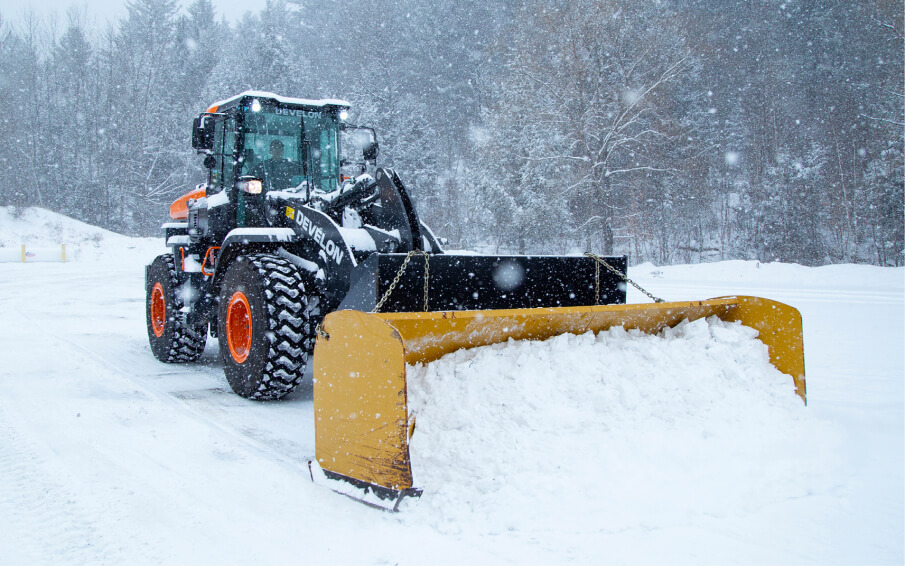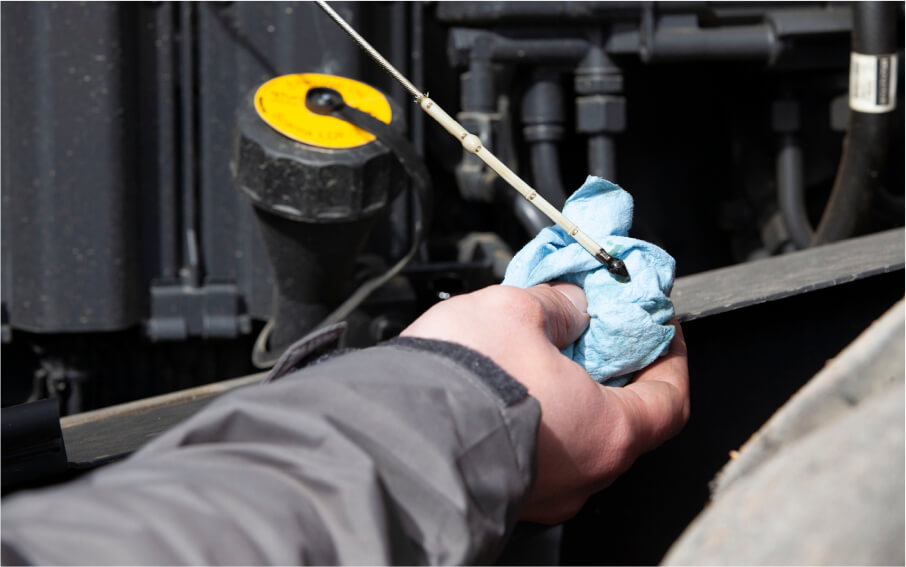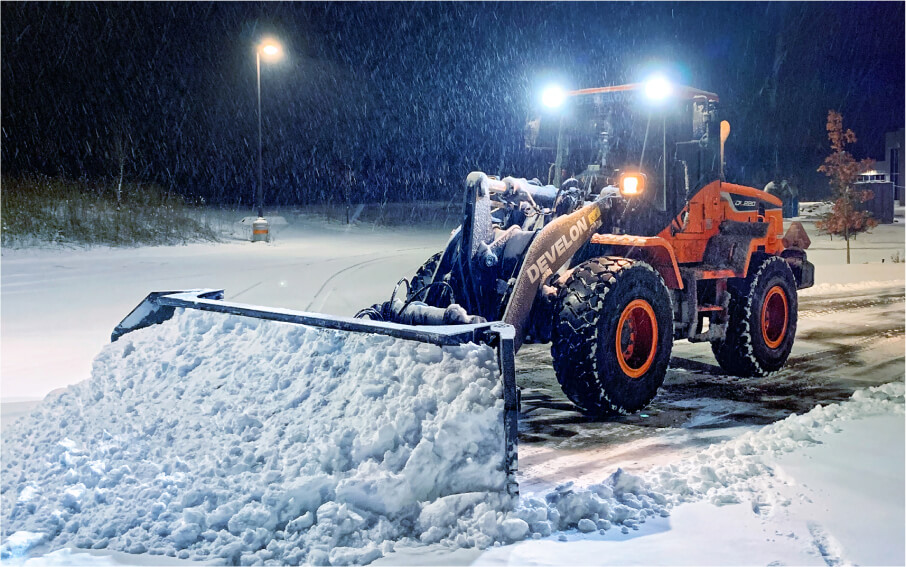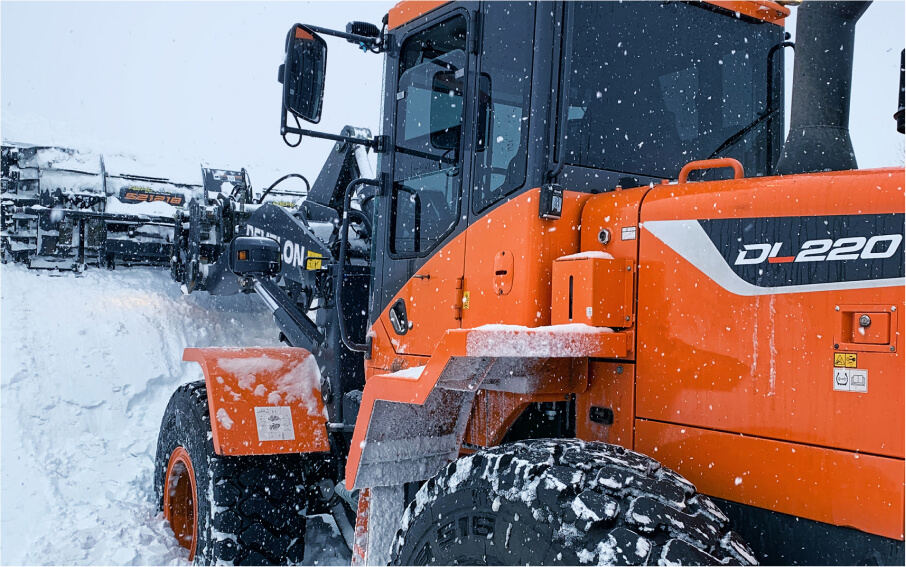How to Prep Your Wheel Loader for Winter
- 30/04/24
- 7 read

Wheel loaders are workhorses in the harshest of winter conditions: They lift and carry heavy materials and push and dump snow. But, to take on these tasks efficiently and safely, proper maintenance is essential.
Follow these nine tips to help you get the most out of your wheel loader this winter.
1. Start Prepping Early for Winter Wheel Loader Care
Don’t wait until the last minute to winterize your wheel loader. Chaise Ireland, president of Conestoga Contracting in Elmira, Ontario — which receives 41.8 inches of snow on average each year — recommends starting in July and completing all repairs by November 1.
“We like to start our triage process early in case we have any issues with parts or materials, but our local dealer, CG Equipment, is always great at stocking the parts we need,” says Chaise. “We make a list, order the parts and maintain and repair our equipment in our shop.”Preventive maintenance and triaging future minor repairs is crucial to keep Chaise’s operation running smoothly.
“Our fleet team records minor issues, completes periodic equipment checks and puts the equipment out of service to carry out the repairs instead of losing days of production,” he says. “They will often perform these inspections on-site to ensure maximum uptime. We track the service hours and intervals via our GPS management software along with the DEVELON Fleet Management solution.”
The operation manual lists recommended service intervals, a checklist of seasonal maintenance items, and oil and fluid recommendations for your construction equipment. The manual will explain which wheel loader components should be regularly inspected, including fluids and filters, the battery, tire pressure, grease intervals and heating and defrosting systems. Chaise recommends greasing all equipment points with a lighter grease for winter months.
You can also request training on proper wheel loader and heavy equipment maintenance techniques from your local DEVELON dealer. They will help you become familiar with decals and key maintenance points on the wheel loader so you can better care for your machine this winter.
2. Switch the Engine Oil
Pair wheel loader fluids to outside temperatures. Most wheel loader manufacturers recommend CJ4 engine oils to protect the machine’s vital engine components.
Using incorrect diesel engine oil can cause costly damage to the machine’s internal components. In addition, components can become plugged or corroded and not work efficiently.
Refer to your operation manual for instructions on filling your machine at the recommended intervals with the appropriate fluid, including hydraulic oil, in the correct increments.

3. Use a Winter Fuel Grade
Switch to a special winter fuel grade, such as No. 1 and No. 2 diesel or a winterized blend.
No. 1 grade diesel fuel has lower energy components than its counterpart, No. 2 grade, because paraffin (a type of wax) has been removed from the chemical mix. The absence of this chemical allows it to remain in liquid form during winter. The downside of No. 2 diesel is its tendency to transform into a thickened gel when the temperature drops. This can often lead to hard starts and other complications during winter.
Winterized fuel is a combination of No. 1 and No. 2 fuels. When blended, they hold a higher concentration of No. 1 grade fuel and are used when it becomes too cold, starting at 14 degrees. The combination of both grades should contain enough energy components and lubricant properties to reduce the chance of the chemical mix gelling in colder temperatures.
Other tips:
- Keep the fuel tank full to prevent moisture buildup, and add a fuel stabilizer to avoid fuel gelling in extremely low temperatures.
- Verify the quality of fuel you are using from your provider, checking to make sure water and other contaminants are not present in your fuel.
- Follow proper fuel management practices as outlined in the operation manual.
4. Inspect Diesel Exhaust Fluid and Adjust the Coolant
In very cold temperatures, diesel exhaust fluid (DEF) can freeze, so keep DEF in storage during the winter months.
Also, inspect the coolant to make sure it’s free of impurities as you run the engine. If the coolant needs to be replaced, choose the best grade for your machine and region. For your machine to perform well in colder weather, the antifreeze mix must be properly blended.
5. Check the Wheel Loader Snow Tires and Batteries
Before cold weather hits, inspect the wheel loader’s tires to make sure they are properly inflated. Undetected leaks or improper inflation can lead to reduced tire wear and potentially failure over time.
L3 radial tires have deeper treads and provide good traction in snowy conditions. Inflating tires with nitrogen gas can be a good alternative to assist in maintaining proper tire pressure.
Test the battery and charge it if needed. Batteries should always be fully charged in cold weather. A trickle charger can be connected to help build the voltage at a lower rate, which can improve battery life. Clean the battery connections as well. Corroded terminals can cause hard starting and charging issues. You can also use a battery blanket to help keep the battery warm when your machine is not in use.
6. Inspect Lights and Safety Features
Verify that all lights, including headlights and taillights, are functioning accordingly. Replace any burnt-out bulbs to ensure that your operators have the appropriate lighting when working in low light or at night. If you’re frequently working at night, consider installing additional lighting on your wheel loader. You can purchase work lights to make yourself extra visible to other machines and vehicles in parking lots. Adding a rotating beacon or flasher is a good investment to increase safety. Check local requirements to ensure that your wheel loader is properly equipped for clearing snow.
Additionally, inspect advanced safety features such as proximity sensors (object detection), camera systems, blind spot monitoring and the industry-exclusive Transparent Bucket feature — now standard on new DEVELON wheel loaders — before operating during winter.
Around view monitor (AVM) camera systems are becoming increasingly popular in wheel loaders. These systems use cameras mounted on the machine to provide as much as 270 degrees of visibility to the surrounding area, giving your operators better situational awareness. Some around view monitor systems include such features as object detection and warning systems, which sound an alert if there are any potential hazards in the machine’s path.

7. Pay Attention to Attachments
Attachments such as quick couplers, buckets and snow pushers deserve the same attention as the wheel loader itself.According to Chaise, his team follows all manufacturer’s instructions as well as performing visual checks of attachment components, such as hoses, cylinders, guards and cutting edges, for damage.
He also follows these tips:
- Add oil spray pre- and post-season.
- Install shrink-wrap in the summer months to help with equipment aging.
- Work closely with a local dealer to ensure that they have parts in stock at a moment’s notice.
- Keep additional snow plows on hand in the event there is an issue that cannot be fixed quickly. As part of Chaise’s strategic planning, his team keeps attachments in certain cities they service so they can swap and go quickly without wasting any downtime.
- Maintain three points of contact when entering or exiting the machine, as frozen material can build up during the day, resulting in a slippery surface.
Also, make sure snow pusher attachments interfacing with a bucket are properly secured with chains.
8. Prep for Storage
When you are done with your wheel loader for the day, park it in an enclosed, heated facility or out of the wind to protect it from the elements. Storing your wheel loader near where you will be moving snow keeps operations efficient. Many facilities even keep the wheel loader stationed on-site during the snow and ice season.
If you are unable to keep your wheel loader inside a building during winter, consider a block heater; available as an option on DEVELON wheel loaders. A block heater will help keep the machine’s engine warm, making it easier to start while reducing wear on engine components. If you do not have a block heater, consider purchasing and installing one this fall.

9. Promote Continuous Operator Training
Pair wheel loader fluids to outside temperatures. Most wheel loader manufacturers recommend CJ4 engine oils to protect the machine’s vital engine components.
Using incorrect diesel engine oil can cause costly damage to the machine’s internal components. In addition, components can become plugged or corroded and not work efficiently.
Refer to your operation manual for instructions on filling your machine at the recommended intervals with the appropriate fluid, including hydraulic oil, in the correct increments.
 Looking to purchase our collection?
Looking to purchase our collection?
Write to us at info@elvaan.com and
add subject line 'Got Swag'
-
Mississauga
2355, Cawthra Road, Mississauga, Ontario
L5A 2W7 -
Orillia
47 Forest Plain Road, Oro-Medonte, Ontario L3V 0R4
-
Edmonton
10807-209 St, Edmonton, Alberta T5S 1Z7













